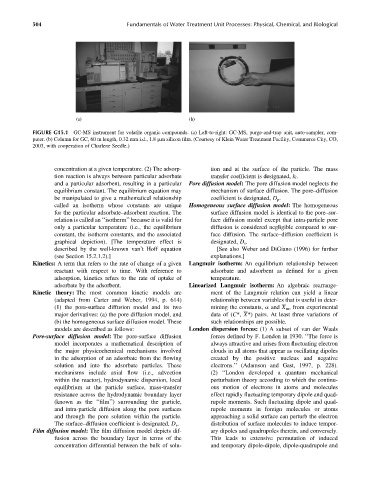Page 549 - Fundamentals of Water Treatment Unit Processes : Physical, Chemical, and Biological
P. 549
504 Fundamentals of Water Treatment Unit Processes: Physical, Chemical, and Biological
(a) (b)
FIGURE G15.1 GC-MS instrument for volatile organic compounds. (a) Left-to-right: GC-MS, purge-and-trap unit, auto-sampler, com-
puter. (b) Column for GC, 60 m length, 0.32 mm i.d., 1.8 mm silicon film. (Courtesy of Klein Water Treatment Facility, Commerce City, CO,
2003, with cooperation of Charlene Seedle.)
concentration at a given temperature. (2) The adsorp- tion and at the surface of the particle. The mass
tion reaction is always between particular adsorbate transfer coefficient is designated, k f .
and a particular adsorbent, resulting in a particular Pore diffusion model: The pore diffusion model neglects the
equilibrium constant. The equilibrium equation may mechanism of surface diffusion. The pore–diffusion
be manipulated to give a mathematical relationship coefficient is designated, D p .
called an isotherm whose constants are unique Homogeneous surface diffusion model: The homogeneous
for the particular adsorbate–adsorbent reaction. The surface diffusion model is identical to the pore–sur-
relation is called an ‘‘isotherm’’ because it is valid for face diffusion model except that intra-particle pore
only a particular temperature (i.e., the equilibrium diffusion is considered negligible compared to sur-
constant, the isotherm constants, and the associated face diffusion. The surface–diffusion coefficient is
graphical depiction). [The temperature effect is designated, D s .
described by the well-known van’t Hoff equation [See also Weber and DiGiano (1996) for further
(see Section 15.2.1.2).] explanations.]
Kinetics: A term that refers to the rate of change of a given Langmuir isotherm: An equilibrium relationship between
reactant with respect to time. With reference to adsorbate and adsorbent as defined for a given
adsorption, kinetics refers to the rate of uptake of temperature.
adsorbate by the adsorbent. Linearized Langmuir isotherm: An algebraic rearrange-
Kinetic theory: The most common kinetic models are ment of the Langmuir relation can yield a linear
(adapted from Carter and Weber, 1994, p. 614) relationship between variables that is useful in deter-
(1) the pore-surface diffusion model and its two mining the constants, a and X m , from experimental
major derivatives: (a) the pore diffusion model, and data of (C*, X*) pairs. At least three variations of
(b) the homogeneous surface diffusion model. These such relationships are possible.
models are described as follows: London dispersion forces: (1) A subset of van der Waals
Pore-surface diffusion model: The pore-surface diffusion forces defined by F. London in 1930. ‘‘The force is
model incorporates a mathematical description of always attractive and arises from fluctuating electron
the major physicochemical mechanisms involved clouds in all atoms that appear as oscillating dipoles
in the adsorption of an adsorbate from the flowing created by the positive nucleus and negative
solution and into the adsorbate particles. These electrons.’’ (Adamson and Gast, 1997, p. 228).
mechanisms include axial flow (i.e., advection (2) ‘‘London developed a quantum mechanical
within the reactor), hydrodynamic dispersion, local perturbation theory according to which the continu-
equilibrium at the particle surface, mass-transfer ous motion of electrons in atoms and molecules
resistance across the hydrodynamic boundary layer effect rapidly fluctuating temporary dipole and quad-
(known as the ‘‘film’’) surrounding the particle, rupole moments. Such fluctuating dipole and quad-
and intra-particle diffusion along the pore surfaces rupole moments in foreign molecules or atoms
and through the pore solution within the particle. approaching a solid surface can perturb the electron
The surface–diffusion coefficient is designated, D s . distribution of surface molecules to induce tempor-
Film diffusion model: The film diffusion model depicts dif- ary dipoles and quadrupoles therein, and conversely.
fusion across the boundary layer in terms of the This leads to extensive permutation of induced
concentration differential between the bulk of solu- and temporary dipole-dipole, dipole-quadrupole and

